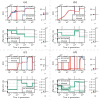Inferring number of populations and changes in connectivity under the n-island model
- PMID: 33846579
- PMCID: PMC8178352
- DOI: 10.1038/s41437-021-00426-9
Inferring number of populations and changes in connectivity under the n-island model
Erratum in
-
Correction: Inferring number of populations and changes in connectivity under the n-island model.Heredity (Edinb). 2022 May;128(5):386. doi: 10.1038/s41437-022-00511-7. Heredity (Edinb). 2022. PMID: 35301466 Free PMC article. No abstract available.
Abstract
Inferring the demographic history of species is one of the greatest challenges in populations genetics. This history is often represented as a history of size changes, ignoring population structure. Alternatively, when structure is assumed, it is defined a priori as a population tree and not inferred. Here we propose a framework based on the IICR (Inverse Instantaneous Coalescence Rate). The IICR can be estimated for a single diploid individual using the PSMC method of Li and Durbin (2011). For an isolated panmictic population, the IICR matches the population size history, and this is how the PSMC outputs are generally interpreted. However, it is increasingly acknowledged that the IICR is a function of the demographic model and sampling scheme with limited connection to population size changes. Our method fits observed IICR curves of diploid individuals with IICR curves obtained under piecewise stationary symmetrical island models. In our models we assume a fixed number of time periods during which gene flow is constant, but gene flow is allowed to change between time periods. We infer the number of islands, their sizes, the periods at which connectivity changes and the corresponding rates of connectivity. Validation with simulated data showed that the method can accurately recover most of the scenario parameters. Our application to a set of five human PSMCs yielded demographic histories that are in agreement with previous studies using similar methods and with recent research suggesting ancient human structure. They are in contrast with the view of human evolution consisting of one ancestral population branching into three large continental and panmictic populations with varying degrees of connectivity and no population structure within each continent.
Conflict of interest statement
The authors declare no competing interests.
Figures








Similar articles
-
The IICR (inverse instantaneous coalescence rate) as a summary of genomic diversity: insights into demographic inference and model choice.Heredity (Edinb). 2018 Jan;120(1):13-24. doi: 10.1038/s41437-017-0005-6. Epub 2017 Nov 8. Heredity (Edinb). 2018. PMID: 29234166 Free PMC article.
-
On the importance of being structured: instantaneous coalescence rates and human evolution--lessons for ancestral population size inference?Heredity (Edinb). 2016 Apr;116(4):362-71. doi: 10.1038/hdy.2015.104. Epub 2015 Dec 9. Heredity (Edinb). 2016. PMID: 26647653 Free PMC article.
-
The IICR and the non-stationary structured coalescent: towards demographic inference with arbitrary changes in population structure.Heredity (Edinb). 2018 Dec;121(6):663-678. doi: 10.1038/s41437-018-0148-0. Epub 2018 Oct 7. Heredity (Edinb). 2018. PMID: 30293985 Free PMC article.
-
What is a population? An empirical evaluation of some genetic methods for identifying the number of gene pools and their degree of connectivity.Mol Ecol. 2006 May;15(6):1419-39. doi: 10.1111/j.1365-294X.2006.02890.x. Mol Ecol. 2006. PMID: 16629801 Review.
-
What can genetics tell us about population connectivity?Mol Ecol. 2010 Aug;19(15):3038-51. doi: 10.1111/j.1365-294X.2010.04688.x. Mol Ecol. 2010. PMID: 20618697 Review.
Cited by
-
Accelerated Bayesian inference of population size history from recombining sequence data.bioRxiv [Preprint]. 2024 Mar 27:2024.03.25.586640. doi: 10.1101/2024.03.25.586640. bioRxiv. 2024. PMID: 38585997 Free PMC article. Preprint.
-
Accounting for population structure and data quality in demographic inference with linkage disequilibrium methods.Nat Commun. 2025 Jul 1;16(1):6054. doi: 10.1038/s41467-025-61378-w. Nat Commun. 2025. PMID: 40592851 Free PMC article.
-
Heterogeneity in effective size across the genome: effects on the inverse instantaneous coalescence rate (IICR) and implications for demographic inference under linked selection.Genetics. 2022 Mar 3;220(3):iyac008. doi: 10.1093/genetics/iyac008. Genetics. 2022. PMID: 35100421 Free PMC article.
-
Ignoring population structure in hominin evolutionary models can lead to the inference of spurious admixture events.Nat Ecol Evol. 2025 Feb;9(2):225-236. doi: 10.1038/s41559-024-02591-6. Epub 2024 Dec 13. Nat Ecol Evol. 2025. PMID: 39672950
-
The importance of well protected forests for the conservation genetics of West African colobine monkeys.Am J Primatol. 2023 Jan;85(1):e23453. doi: 10.1002/ajp.23453. Epub 2022 Dec 5. Am J Primatol. 2023. PMID: 36468411 Free PMC article.
References
Publication types
MeSH terms
LinkOut - more resources
Full Text Sources
Other Literature Sources

